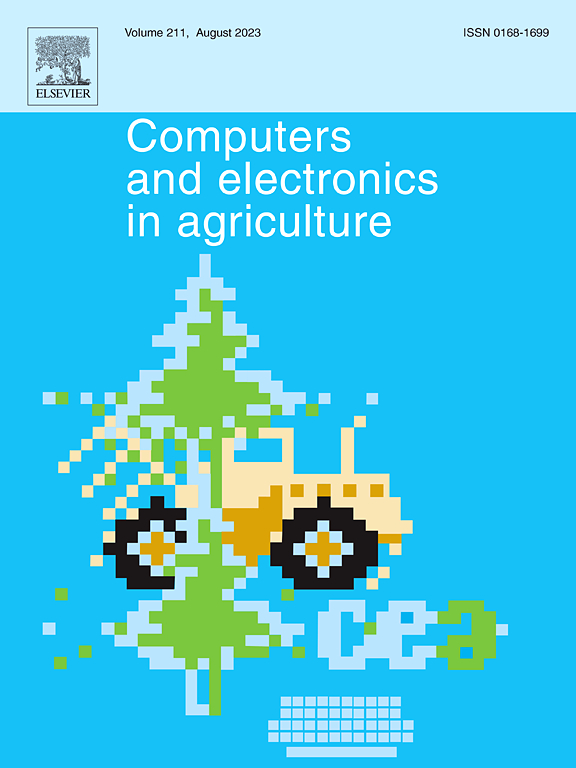生物质生产模型与临界氮浓度机器学习回归相结合估算草地氮素需要量
IF 8.9
1区 农林科学
Q1 AGRICULTURE, MULTIDISCIPLINARY
引用次数: 0
摘要
本文提出了一个基于遥感冠层反射率估算多年生黑麦草和混合草地氮素需水量的模型集。我们设计了一个由两层组成的管道,一层使用机器学习回归(MLR)估计植物N浓度(PNC),另一层使用涉及环境约束的改进的卡内基-艾姆斯-斯坦福方法(CASA)估计生物质产量。从随机森林筛选、多任务高斯过程、偏最小二乘法和支持向量回归中选择第一种最小二乘法预测现场实测PNC。估算的PNC和生物量位于根据现场数据开发的临界氮稀释曲线上,以精确诊断连续两次切割之间的NR。为了进行对比,将管道与野外和航空尺度下的冠层反射率数据进行对比。利用4个MLRs直接估算了田间数据估算的植物氮吸收(PNU)、氮营养指数(NNI)和NR,并与管道估算结果进行了比较,揭示了涉及生物量估算的模型集合管道的附加价值。与作为输入的波段反射率相比,大多数MLRs用植被指数估计出更好的PNC。在野外和航空尺度上,所有MLRs对黑麦草N变量的估计都优于混合草地,其中偏最小二乘回归在12-15 kg N ha−1时的RMSE最低。在几乎所有的情况下,偏最小二乘回归表现稳定,与其他MLRs相比,RMSE较低。将该回归量整合到两个草地系统的双层管道中,在田间尺度上,与仅使用MLRs相比,PNU、NNI和NR的RMSE分别从20 ~ 30 ~ 19 kg N ha−1、0.15 ~ 0.20 ~ 0.13和13 ~ 21 ~ 8 kg N ha−1降低。在航空尺度上,NNI和NR的RMSE分别从0.15 - 0.28和12-18降至11 kg N ha - 1,而PNU没有差异。MLRs在机载条件下对PNC的估计优于在野外条件下,而双层管道在野外条件下的估计效果更好。总体而言,研究表明,不同MLRs的冠层反射率数据和植被指数与不同阶段N状态的相关性相对一致,无论是单独使用还是整合到CASA等生产力模型中,都可以准确估算多年生单一和混合草地等复杂农艺系统的NR。考虑到草类的CASA模型可以在考虑地下生物量的情况下得到很大的改进,因此研究表明,该模型集合具有很高的潜力,可以高精度地估计不同草地的NR,从而显著优化氮肥的使用。该研究还为高日分辨率的草氮状态远程定量诊断提供了新知识。本文章由计算机程序翻译,如有差异,请以英文原文为准。
Combining biomass production model with machine learning regression of critical nitrogen concentration for estimating grassland nitrogen requirements
This paper presents a modelling ensemble to estimate nitrogen requirements (NR) for perennial ryegrass and mixed grasslands from remotely sensed canopy reflectance. We designed a pipeline consisting of two layers, one estimating plant N concentration (PNC) using machine learning regression (MLR), and another estimating biomass production using an improved Carnegie-Ames-Stanford Approach (CASA) involving environmental constraints. The MLR in the first later was selected from screening of random forest, multitask gauss process, partial least square and support vector regression to predict the field measured PNC. The estimated PNC and biomass were located in the critical nitrogen dilution curve developed from the field data to precisely diagnose NR between two consecutive cuts. For comparison, the pipeline was conducted with canopy reflectance data obtained at field and airborne scale. Plant N uptake (PNU), nitrogen nutritional index (NNI) and NR estimated from the field data were also estimated directly by the four MLRs and compared with the pipeline estimates to reveal the added value of the modelling ensemble pipeline involving biomass estimation.
Most MLRs estimated better PNC with vegetation indices compared to band reflectance given as input. All MLRs estimated better the N variables of ryegrass than of the mixed grasslands at both field and airborne scale, with partial least square regression having the lowest RMSE for NR of 12–15 kg N ha−1. In nearly all cases, partial least square regression performed stable with lower RMSE compared to the other MLRs. When this regressor was integrated in the dual-layer pipeline for the two grassland systems, the RMSE decreased compared to using only MLRs for PNU, NNI and NR from, respectively, 20–30 to 19 kg N ha−1, 0.15–0.20 to 0.13 and 13–21 to 8 kg N ha−1 at field scale. At airborne scale the RMSE of NNI and NR decreased from, respectively, 0.15–0.28 to 0.15 and 12–18 to 11 kg N ha−1 with no difference for the PNU. The PNC was estimated better by MLRs at airborne than at field cale, while the dual-layer pipeline performed better at field scale.
Overall, the study shows that canopy reflectance data and vegetation indices have relatively consistent correlation to N status across different stages for different MLRs, either as stand-alone or integrated in productivity models such as CASA to accurately estimate NR of complex agronomic systems such as perennial single and mixed grasslands. Considering the CASA modelling of the grasses can be considerably improved in relation to belowground biomass considerations, the study thus reveals a significant potential of the modelling ensemble to estimate NR of different grasslands with high accuracy and thus significantly optimize N fertilizer use. The study also provides new knowledge of remote quantitative diagnosis of grass N status with high daily resolution.
求助全文
通过发布文献求助,成功后即可免费获取论文全文。
去求助
来源期刊

Computers and Electronics in Agriculture
工程技术-计算机:跨学科应用
CiteScore
15.30
自引率
14.50%
发文量
800
审稿时长
62 days
期刊介绍:
Computers and Electronics in Agriculture provides international coverage of advancements in computer hardware, software, electronic instrumentation, and control systems applied to agricultural challenges. Encompassing agronomy, horticulture, forestry, aquaculture, and animal farming, the journal publishes original papers, reviews, and applications notes. It explores the use of computers and electronics in plant or animal agricultural production, covering topics like agricultural soils, water, pests, controlled environments, and waste. The scope extends to on-farm post-harvest operations and relevant technologies, including artificial intelligence, sensors, machine vision, robotics, networking, and simulation modeling. Its companion journal, Smart Agricultural Technology, continues the focus on smart applications in production agriculture.
 求助内容:
求助内容: 应助结果提醒方式:
应助结果提醒方式:


